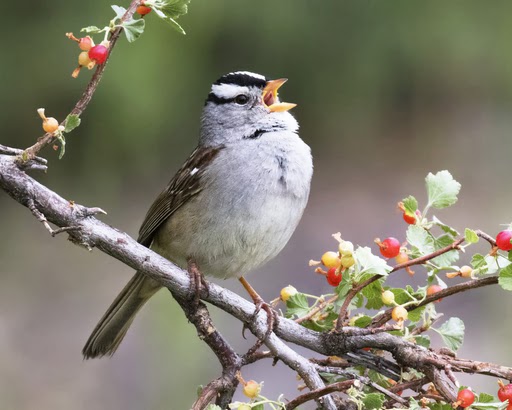Birds are able to produce sounds through a specialized organ called a syrinx. They sing for various reasons, such as attracting a mate, warning others of danger, and scaring away predators. In the morning, we can hear a mixture of different bird songs outside our windows. In urban areas, the soundscape is filled with the high-pitched chirping of bulbuls, the loud cawing of crows, and the annoying cooing of pigeons. In more rural areas, you may come across the melodic call of a peacock or the repetitive sound of a roller bird. The image shows an Indian roller bird perching on a branch.
During the months of May to July, juvenile crows can be heard making vocalizations to request food from their parents. However, as the year progresses, these sounds will cease. What causes this change in calls, and what is the purpose behind the vocalizations of birds?
Birds produce a wide variety of sounds and their calls change for different reasons. But how do they actually make these sounds? And why do birds call in the first place?
To understand this, we need to look at the specific group of birds that can sing and call – the Passeriformes. These birds, also known as passerines, have a unique arrangement of their toes that allows them to perch on various surfaces like branches, twigs, and even electrical wires. This ability to perch gives them the stability and balance they need to produce their beautiful melodies.
The origin of bird song can be traced back to the Cretaceous era, approximately 66 to 69 million years ago. It is believed that the ancestors of present-day birds, which were likely dinosaurs, exhibited the ability to produce songs similar to those of birds.
Humans and other mammals have a larynx, which is also called the vocal cords or voice box. The larynx is a tube that connects the throat (pharynx) with the respiratory system. It is located above the pathway that goes to the lungs, and enables us to communicate and utilize our voices.

If opera singers possessed a syrinx, it would be advantageous. Birds, on the other hand, possess a larynx, which is not involved in producing sounds like mammals do. Instead, birds possess a songbox, referred to as the syrinx.
The syrinx is located much lower in the respiratory system of birds, specifically at the branch just before the lungs. The syrinx has muscles on both the left and right sides, which have the ability to move independently. This allows for the production of two distinct sounds. The unique structure of the syrinx allows birds to create songs that utilize this feature, resulting in a harmonious combination of two different pitches and volumes, resembling the sound of two musical instruments playing together.
The Importance of the Syrinx in Bird Evolution
If you are interested in understanding the mechanism behind bird vocalization, you can find detailed information on how the syrinx works here.
The syrinx, which is considered a crucial development in bird evolution, played a significant role in the rapid diversification of birds. This innovation acted as a catalyst, leading to the emergence of thousands of species over millions of years, as evidenced by the first fossil record of the syrinx.
How Do Birds Acquire the Ability to Sing?
Not all birds communicate in the same way, or even in similar ways. Some species have a wide range of complex songs that can last for several minutes. Other species have only a few short calls. This affects how long it takes for young birds of a species to learn all of their songs.
The process of developing bird songs in all species can be divided into three phases: the sensory phase, the sensorimotor phase, and the crystallized phase.
Explaining how birds learn to sing is comparable to understanding how children learn and speak languages.
In the early stage of development, young birds, especially males, actively listen to various birds in order to learn the specific songs sung by adult birds of their species. This process can be compared to how children babble and experiment with sounds when learning to speak. In the following stage, known as the sensorimotor phase, young birds test out different segments of songs and calls, playing with them and observing how they fit together, similar to words forming sentences. Finally, in the crystallized phase, the bird’s song and repertoire become established, allowing them to communicate effectively.
Certain avian species, such as Zebra finches, undergo a single phase of sensory and sensorimotor learning in their lifetime. On the other hand, canaries continue to learn throughout their lives, transitioning between the three phases as necessary.
Innate or Acquired?
Is bird song a result of learning or is it an innate capability that manifests during adulthood?
When birds are raised in isolation with only humans for companionship, they do develop some songs. However, these songs are markedly different from those of their species; they are brief, awkward, and abnormal. Nonetheless, birds possess an inherent ability to identify the calls of their own species, as they do not learn the songs of other birds.
The location where they mature is also significant. The melodies of birds, like those sung by the white-crowned sparrow, appear to exhibit regional distinctions. Birds that are isolated and exposed to songs from a particular dialect integrate them into their own melodies, irrespective of their original origin.
 A White-Crowned Sparrow, which is indigenous to North America and is extensively researched for its bird song (Photo Credit: rbrown10/Shutterstock)
A White-Crowned Sparrow, which is indigenous to North America and is extensively researched for its bird song (Photo Credit: rbrown10/Shutterstock)
Scientists have also delved into the avian brain and identified distinct areas that regulate specific elements of bird vocalizations.

The learning and growth of bird songs engage various parts of their brain. (Photo Credit: Nottebohm F/Wikimedia commons)
To produce melodic sounds, birds require well-functioning brains and interaction with their fellow species. However, what is the reason behind the advantageous impact of singing ability on bird fitness?
What is the reason behind birds singing?
Birds have a complex way of singing, which includes a separate organ, specific areas in the brain, and a long period of learning. All of these require energy, so what is the advantage of this? Why does evolution support bird singing?
One purpose of bird singing is to sound the alarm. Certain species like Pygmy owls, Drongos, and American Robins hunt in groups and use calls to warn each other when there are larger predators nearby. This allows the entire group to escape. It is believed that these alarm calls even create mental images of the specific predators for the birds that hear them.
Social birds, such as babblers, crows, and pigeons, rely on calls to communicate with each other. Interestingly, Japanese Great tits have been observed to have a form of syntax in their calls. If a song is played out of order, members of their species do not respond. Effective communication among birds leads to improved sharing of resources, better predator avoidance, and overall community health.
Here is an image of a Japanese Great Tit perched on a tree branch. [Image] (Photo Credit: Hawk777/Shutterstock)
It is widely believed that birds sing primarily to attract mates. Female birds tend to choose males with longer and more intricate songs. Charles Darwin proposed the idea that the quality of a bird’s song reflects its suitability as a mate hundreds of years ago, but only recently has new evidence emerged to support this theory. Birds with a wider range of songs were likely better fed during their youth, which provided them with extra energy for both physical development and for practicing and learning songs. Furthermore, there appears to be a connection between the complexity of a bird’s song and its immune health.
Summary
The syrinx is the main innovation that enabled birds to thrive and adapt to diverse habitats and environments. While different bird species have varying methods of learning bird songs, it is essential for them to receive instruction from members of their own species.
Although bird song is complex and requires a lot of energy, it offers numerous benefits to bird species. It can even assist female birds in selecting superior mates, ultimately enhancing the overall fitness of the bird population.
The Importance of Bird Song for Avian Survival
It is well-known that bird song is a common occurrence in nature. Over the years, numerous studies have been conducted to explore the reasons behind this delightful trait and its significance for the survival of birds.
